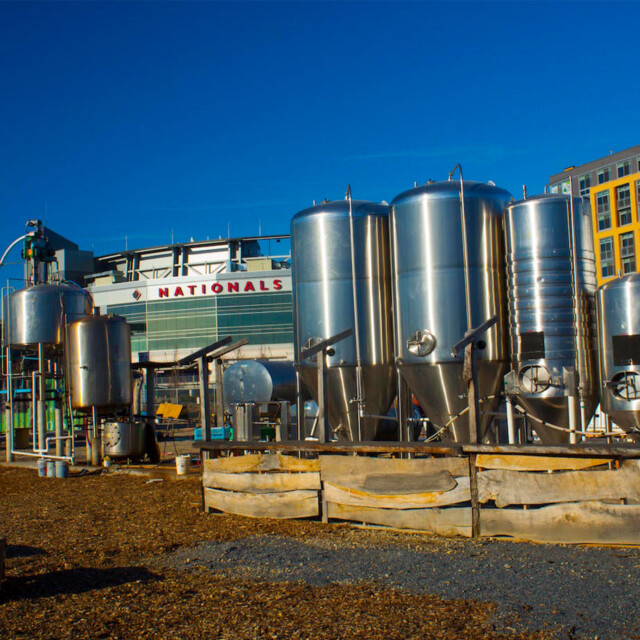I think most of all I remember the garbage.
In a mostly vacant lot in one of Washington, D.C.’s worst neighborhoods, I was poking at chunks of macerated fruit in my beer and wondering what people saw in this place. Scattered around me were picnic benches, various pieces of brewing equipment, an aluminum skull with beer cans for teeth, and a wooden armoire, all of which were either meant to be used or had been left to rot. It was difficult to assess which.
That was my one and only visit to Bardo, which around this same time in 2015 earned a spot on Time Out’s 22 Best Beer Gardens in America. Even today the appeal is difficult to parse, but maybe it’s worth doing so in light of beer’s tanking market share and today’s mass closure of craft breweries. As Americans turn a colder and colder shoulder to their once beloved craft beer, there’s a great deal of wisdom to be gained by considering a brewery that truly pushed the boundaries of weirdness — and got away with it.
Arts & Crafts
In 1995 Jonathan Reeves took a pay cut to chase a dream and became the fourth person ever to work in Bardo’s brewhouse.
“I met [the owner],” Reeves says, “and he said, ‘Well, the best way to learn about running a brewery is to come work for one.’”
Bardo’s original location was a repurposed car dealership in the Washington, D.C., suburbs. The sign out front said “Brewery” even though the word “Oldsmobile” was still plainly visible underneath. There was an old Plymouth Fury that had been made to look like it was crashing into the building, and on the inside there were massive murals that would be worked on for months and then completely abandoned.
“When you came in in the morning you could hear the pieces of paint falling off the ceiling,” Reeves recalls. The first-time brewer was preceded in his job by a guy who had recently quit, leaving the brewery in the hands of two drug addicts named “Skinlover” and “Shitfreak.”
“They essentially ran the place out of beer,” Reeves says, describing the coworkers who almost killed him on more than one occasion. In a series of what were presumably “pranks,” the brew team’s two senior members had Reeves climb into tanks full of CO2, and once turned the brew kettle on while he was inside of it.
“They ended up getting fired,” Reeves says. “And I ended up becoming the brewer with about maybe two months’ experience.”
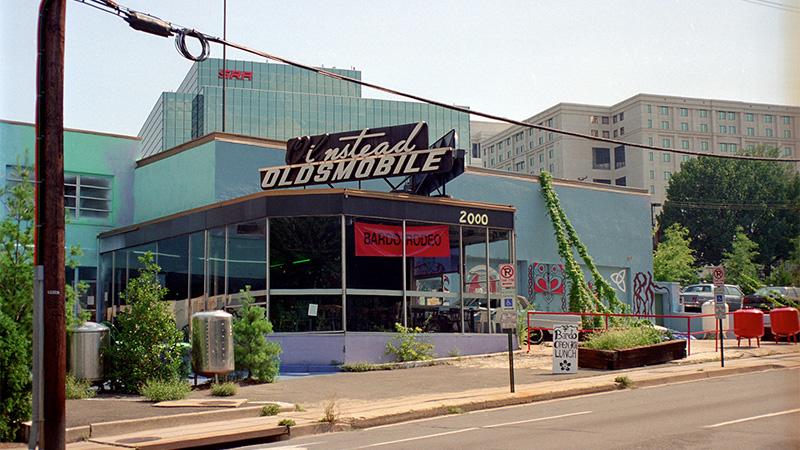
The chaos of Bardo’s early days wasn’t confined to the back of the house, either. In late 1993, a member of the Kennedy family picked a fight with a doorman, and my own father upon hearing I was writing this story told me he once intercepted an airborne pool ball at Bardo that was about to hit his friend in the nuts. Favio Garcia, a later member of the brew team who also picked up bar shifts, told me about a rollout of a 12 percent ABV beer that hit a few snags.
“There were these two girls who were drinking this barleywine,” Garcia says. “They got in a fight — like a physical fight. And I remember [the other bartender] turned to me like ‘maybe we shouldn’t serve those in pint glasses anymore?’”
Despite the “Road House”-style vibes the beer was good. Like, really good. Several of Bardo’s brews took home awards at local and national competitions, including GABF wins for the brewery’s ginger beer, the aforementioned barleywine, and the “Dremo Tibetan Sasquatch” strong ale.
“I think he was the first in that regard,” says former regular Rick Otis in reference to Bardo’s enigmatic founder. “There’s at that point no brewpub that specializes in Brettanomyces and sour beers; no brewpub that specializes in Belgians. Nobody had craft beer around.”
Town & Country
Craft beer in 1993 wasn’t nearly as accessible as it is today. Household names like Victory and Smuttynose didn’t exist yet, and a plucky little upstart called Lagunitas was still getting its feet under it in California. Meanwhile, a restaurateur in the D.C. area named Bill Stewart had noticed how difficult it was to get good beer on tap at his three bars in Virginia and the District. So he decided to make his own.
Stewart leased the defunct car dealership in Arlington, Va., in ‘93 and set about converting it into one of the nation’s first brewpubs. The showroom became the bar, while the sound system of the car crashing through the window became the jukebox, stocked with CDs for everything from Elvis to the Flying Burrito Brothers. The rest of the cavernous space became the brewery. In an era where it was difficult to get much beyond Miller and Bud, Stewart’s shop was churning out creations like the Marion Berry Lambic, made with marionberries in a not-so-loving tribute to D.C.’s mayor.
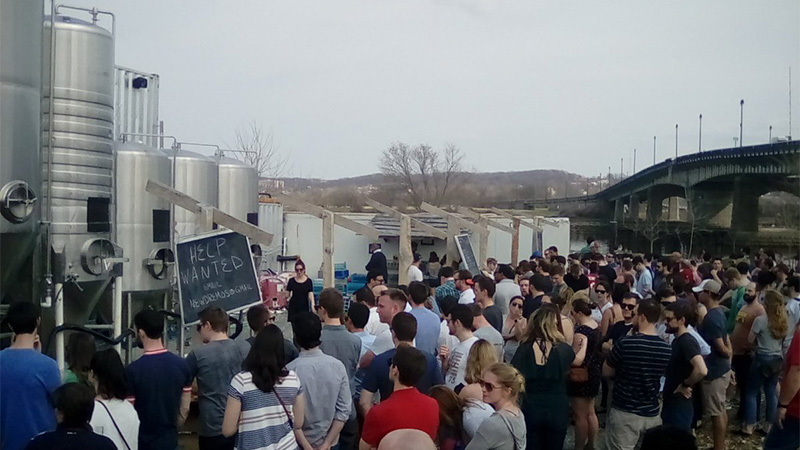
These days, most people who know him describe Stewart as a temperamental savant who basically assembled an entire craft brewery from retrofitted parts he bought at auction.
“Those individuals are usually interesting and odd people because they’re just beginning something that nobody else thought to do,” says Otis. “I mean, who would think of sticking the front end of a 1965 Plymouth out through the window of the building? Pretty Neat.”
In 1999 Bill Stewart moved brewing operations for Bardo to Rappahannock, Va., 70 miles west of Washington. The idea was to make the beer there and sell it at the bar, but that plan ran afoul of America’s infamous three-tier system. Eventually, Stewart had had enough.
“I just sort of got sick of it,” he says.
After a few years Stewart put his brewing equipment into shipping containers and moved to Australia. An attempt at a Bardo spinoff down under never got off the ground but lived on for years in the brewery’s “bardo.au” web address. Stewart later wound up in India, where his brother and occasional business partner tracked him down in the early 2010s. It turned out that after a marked downturn in the early aughts beer was cool again, and the rest of the old Bardo team wanted to capitalize.
There’s a reading of this moment that comes off as wildly cinematic: the old master, pulled out of retirement for one last big score. Stewart however, doesn’t see it that way.
“My brother’s like, ‘Hey, I’m thinking about doing a thing,’” he recalls. “And I was like ‘OK, I can probably pull the brewery out of storage and do something.’”
Trash & Treasure
The headline in The Washington Post from 2013 reads “Bardo is back, without Bardo beers.”
Bardo 3.0 existed on a plot of land in Northeast D.C. that was mostly empty, save for a low-slung structure that had previously doubled as a barbershop and unlicensed strip club. The plan had been to start brewing as soon as they could but there was a problem with the permit. When Stewart submitted his plans, the city had assumed that he intended to enclose his brewery within walls and a roof. They were incorrect. For a year Bardo’s bartenders served guest taps like local hipster darling Natty Boh. The tanks and tuns and other pieces of brewing equipment were there but empty and unused, an impromptu sculpture garden to the idea of beer.
Eventually, Stewart was able to find someone in D.C. government with a sympathetic ear.
“‘If you’re gonna make shitty beer because it’s outside, then whatever,’” says Stewart, paraphrasing the city’s official stance. “‘It’s not like seafood or something where you get a bunch of bad oysters and people are gonna be dead. [If] you make bad beer you’ll go outta business so I’m not gonna really f*cking worry about it.’”
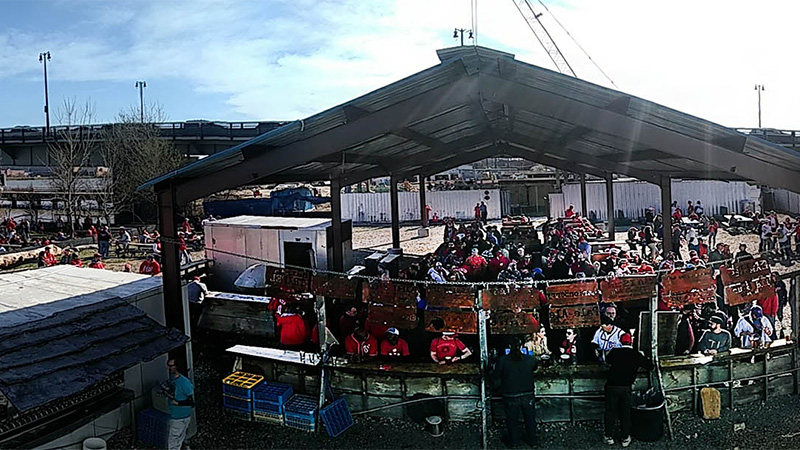
Permit in hand, Bardo still declined to hire a head brewer for the new location, deciding instead to rely on guest brews and old recipes from the ‘90s. By multiple accounts, the beer suffered.
This could have happened for multiple reasons. The lack of anyone in charge day-to-day could certainly have led to a drop-off in quality. Bardo was now its own landlord, meaning they could worry less about beer sales while waiting for the land to appreciate. But then of course there’s the elephant in the wall-less, ceiling-less room.
Stewart poo-poos the idea that brewing outdoors could in any way negatively affect the beer but his two former employees see it differently. Reeves cites the difficulty in keeping things clean and sanitary in an outdoor environment while Garcia has a simpler take.
“I mean, you can make beer outside,” he says. “But I don’t know why you want to.”
Apathy & Entropy
Not long after they’d finally secured a permit, Stewart and co. picked up stakes again. They’d secured a one-acre plot along the Anacostia River, and traded a notoriously crime-riddled neighborhood for some of D.C.’s most valuable real estate.
Plans to relocate the Montreal Expos baseball team to the nation’s capital were announced in 2004, with the city’s once notorious Navy Yard neighborhood playing host to the new stadium. This flipped D.C.’s southwest waterfront from bad to bougie overnight, resulting in the homogenous feel and sterile vibe that often happens when gentrification takes place at warp speed. Most of the establishments down there were — and are — safe, conservative, and predictable.
With one exception.
“The entrance looked like it was built by the children of ‘Lord of the Flies,’” recalls Mary Myers, an actress and D.C.-area native. “It just looked like a land of forgotten things. It looked like shit was just there and people had left it.’”
Bardo’s new home on the waterfront butted up against a yearslong project aimed at restoring the South Capitol Street bridge. This led to some confusion about where, exactly, the beer garden began and ended. “If you wanted to sit on tires and vague benches that were a little bit more artfully constructed, you could do that. But you could also take your beer under a literal goddamn bridge next to a literal goddamn construction site,” Myers says. “Nobody was there to be like, ‘I’m sorry the bar no longer exists here.’”
Despite the advantages of being walking distance from a major league stadium — and the site of a 2019 World Series win — Stewart describes sales at the riverfront location as simply “OK.” He lays the blame at the locals’ feet.
“They’re like, ‘I pay a lot for my apartments and I’m very type-A,” Stewart says, describing his neighbors. “And I don’t really understand this kind of like, off-the-wall stuff.”
That’s certainly a possibility. Stewart’s aesthetic has always lived on the periphery of the status quo and common sense. The declining quality of the beer itself could have also been a factor. But maybe the brewery was bending to factors greater than itself. Beer sales cratered post-pandemic while competing categories like hard seltzers and RTDs soared. Alcohol consumption is down with people under 30. Bardo, in its three other incarnations, always had a knack for showing up right before beer got hot, and leaving right before it crashed. Maybe this was no exception.
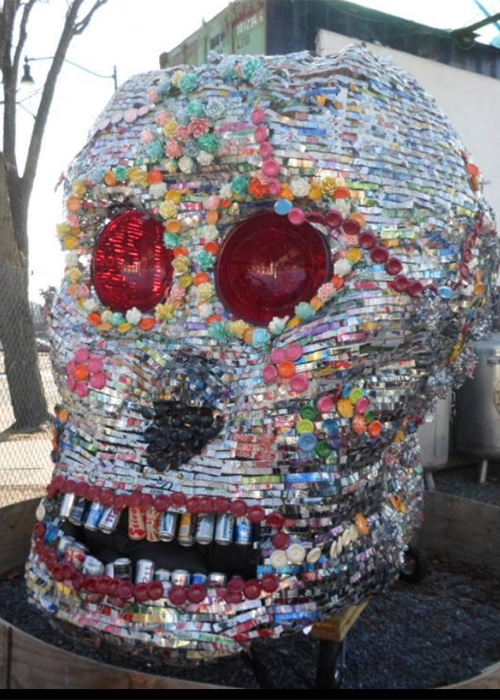
Whatever the case, Stewart let a local restaurant group buy out his lease in 2021. The new tenants rebranded the 45,000-square-foot plot as “The Cove,” a tropical beer garden with plans to keep Bill Stewart’s old MacGyvered beer tanks pumping out product. But as of today, its menu lists Modelo, Corona, and High Noon, but nothing original. The tanks are still there on Instagram. But they’re once again quiet.
The reason might be easy to see if we compare Bardo’s legacy to the early ad campaigns of places like Stone and BrewDog. Beers like Arrogant Bastard and Anarchist Alchemist didn’t just push the limits of ABV and IBUs, they pushed the limits of good taste. Drinking them made you feel like you were taking a risk, like you were engaged in something dangerous.
Bardo might have looked the same from certain angles, but the brewery went one step further. It sold danger. Real, actual danger. Whether you were a patron drinking beer al fresco in a construction site or an employee dodging junkie coworkers trying to kill you, Bardo carried the sense that something genuinely unplanned and unpredictable could happen at any moment. Compare that to the tepid ubiquity of the craft beers on offer at any grocery store, and it’s easy to see why beer has become unrebellious, and therefore uncool.
Favio Garcia and Jonathan Reeves recently sat down for a beer together at Maryland’s Silver Branch Brewing. Reeves is now the brewmaster there while Garcia serves as director of brewing operations at Dynasty Brewing Co. It was the first time the two former Bardo employees had seen one another in a long time.
“Favio has this theory that the whole point of it was entropy,” Reeves says. “That it’s just all supposed to kind of fall apart.”
“I think that if he had really wanted to, he could have been like Dogfish Head before Dogfish Head,” he adds, speaking of his former boss. And maybe so. But then Bill Stewart wouldn’t have been Bill Stewart. And Bardo wouldn’t have been Bardo.
